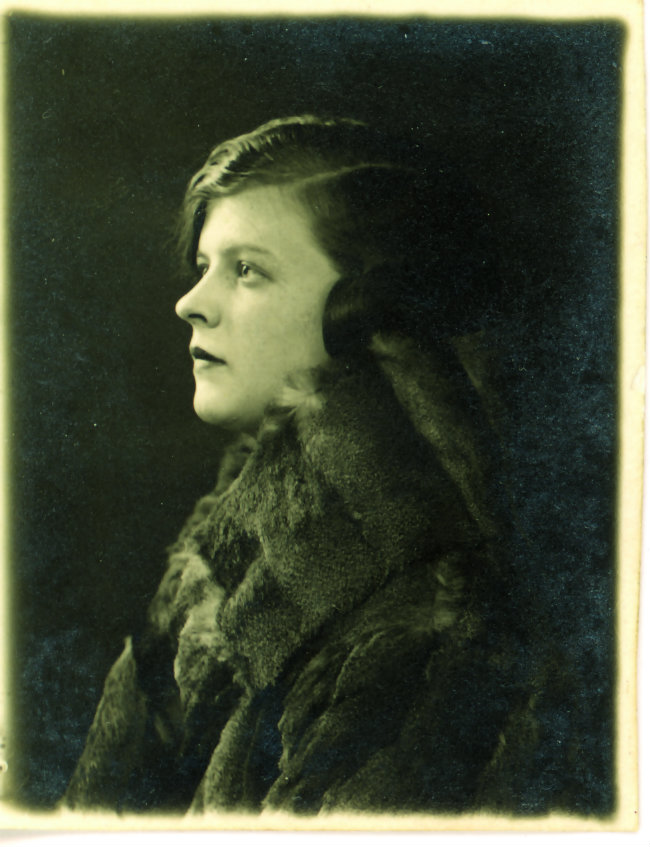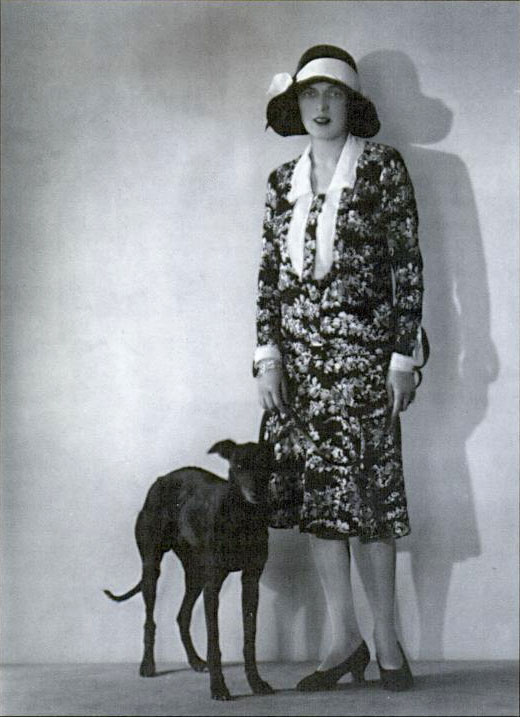Husband
Harry Crosby
Queer Places:
12 Quai d'Orléans, 75004 Paris, France
Le Moulin du Soleil, Ermenonville, France
Castello di Rocca Sinibalda, Italy
Cimetiere de l'Abbaye de Longchamp
Boulogne, Departement de la Vendée, Pays de la Loire, France
 Caresse
Crosby (born Mary Phelps Jacob; April 20, 1891 – January 24, 1970)[1]
was the first recipient of a patent for the modern
bra,[2]
an American patron of the arts, publisher, and the "literary godmother to the
Lost Generation of expatriate writers in Paris." She and her second
husband,
Harry Crosby, founded the
Black Sun Press, which was instrumental in publishing some of the early
works of many authors who would later become famous, among them
Ernest Hemingway,
Archibald MacLeish,
Henry Miller,
Anaïs Nin,
Kay Boyle,
Charles Bukowski,
Hart
Crane, and
Robert Duncan.
Shari Benstock's Women of the Left Bank: Paris, 1900-1940, is a study
devoted principally to thoughtful biographical and literary analyses of
some 22 women: Margaret Anderson,
Djuna Barnes,
Natalie Barney,
Kay Boyle,
Sylvia Beach,
Bryher,
Colette, Caresse Crosby,
Nancy Cunard,
Hilda Doolittle,
Janet Flanner,
Jane Heap,
Maria Jolas,
Mina
Loy, Adrienne Monnier,
Anais Nin,
Jean Rhys,
Solita Solano,
Gertrude Stein,
Alice B. Toklas,
Renee Vivien, and
Edith Wharton, who came to dominate the
landscape of the modernist literary experiment in Paris.
Caresse
Crosby (born Mary Phelps Jacob; April 20, 1891 – January 24, 1970)[1]
was the first recipient of a patent for the modern
bra,[2]
an American patron of the arts, publisher, and the "literary godmother to the
Lost Generation of expatriate writers in Paris." She and her second
husband,
Harry Crosby, founded the
Black Sun Press, which was instrumental in publishing some of the early
works of many authors who would later become famous, among them
Ernest Hemingway,
Archibald MacLeish,
Henry Miller,
Anaïs Nin,
Kay Boyle,
Charles Bukowski,
Hart
Crane, and
Robert Duncan.
Shari Benstock's Women of the Left Bank: Paris, 1900-1940, is a study
devoted principally to thoughtful biographical and literary analyses of
some 22 women: Margaret Anderson,
Djuna Barnes,
Natalie Barney,
Kay Boyle,
Sylvia Beach,
Bryher,
Colette, Caresse Crosby,
Nancy Cunard,
Hilda Doolittle,
Janet Flanner,
Jane Heap,
Maria Jolas,
Mina
Loy, Adrienne Monnier,
Anais Nin,
Jean Rhys,
Solita Solano,
Gertrude Stein,
Alice B. Toklas,
Renee Vivien, and
Edith Wharton, who came to dominate the
landscape of the modernist literary experiment in Paris.
For a while, Kay Boyle lived comfortably as the secretary to
Gladys Palmer, heir to
the Palmer biscuit company fortune and the Princess or Dayang Muda of Sarawak.
Boyle, however, was drawn to a commune outside Paris in Neuilly organized by
Raymond Duncan, brother of Isadora
Duncan. Boyle's daughter, Sharon, would be cared for at the commune (she
was not permitted to live with her mother in Palmer’s home) in exchange for
Boyle’s managing the shop on the boulevard Saint-Germain where the togas,
sandals, and scarves presumably produced by Duncan’s colony were sold. Harry
Crosby often visited Boyle at the shop, episodes that provided Boyle with
material for a number of scenes in her fourth novel, My Next Bride (1934). There was gossip that Harry’s
frequent visits to the boulevard Saint-Germain were not merely shopping
expeditions, and that a ménage à trois or a lesbian relationship between Kay
Boyle and Caresse Crosby existed. None of these speculations were ever
confirmed, although Boyle dedicated My Next Bride to Caresse partly to dispel suspicion.
While not strictly autobiographical, the book sheds light on the early
relationship between the Crosbys and Boyle.
Crosby's parents, William Hearn Jacob and Mary Phelps, were
both descended from American colonial families—her father from the
Van Rensselaer family, and her mother from
William Phelps. In 1915, Mary (nicknamed Polly) married
Richard R. Peabody, another
blue-blooded Bostonian whose family had arrived in New Hampshire in 1635.
They had two children, but while her husband was away at war, she met Harry
Crosby, who was 7 years her junior, at a picnic in 1920. They had sex within
two weeks and their public affair scandalized proper Boston society. After
Richard returned from his service in
World
War I, he returned to drinking; his favorite pastime was to watch
buildings burn.[3]:79
Two years later, he granted Polly a divorce, and Harry and Polly were married.
They immediately left for Europe, where they joined the
Lost Generation of American expatriates. They embraced a
bohemian and decadent lifestyle, living off Harry's
trust fund of US$12,000 a year[4]:397, had an
open marriage with numerous ongoing affairs, a
suicide pact, frequent drug use, wild parties, and long trips abroad. At
her husband's urging, Polly took the name Caresse in 1924. In 1925, they began
publishing their own poetry as Éditions Narcisse in exquisitely
printed, limited-edition volumes. In 1927, they re-christened the business as
the Black Sun Press.[5]

Caresse Crosby and her whippet, Clytoris
They published early works of a number of
avant-garde writers before the writers were well-known, including
James
Joyce's Tales Told of Shem and Shaun (which was later integrated
into
Finnegans Wake). They published
Kay Boyle's
first book-length work, Short Stories, in 1929,[44]
and works by
Hart
Crane,
Ernest Hemingway,
Eugene Jolas,
D. H. Lawrence,
Archibald MacLeish,
Ezra
Pound, and
Laurence Sterne. The Black Sun Press evolved into one of the most
important small presses in Paris in the 1920s. In 1929, Polly and Harry both
signed poet
Eugene Jolas' The Revolution of the Word Proclamation, which
appeared in issue 16/17 of the literary journal
transition. After Harry died, in a
suicide pact with one of his many lovers, Caresse continued publishing
until 1936, when she left Europe for the United States.
Harry's death in 1929 was marked by scandal as the newspapers speculated wildly
about whether Harry shot his lover or not. Caresse returned to Paris, where
she continued to run the Black Sun Press. With the prospect of war looming,
she left Europe in 1936 and married Selbert Young, an unemployed, alcoholic
actor 16 years her junior. They lived on a Virginia plantation they
rehabilitated outside
Washington, D.C., until she divorced him. She moved to Washington, D.C.
and began a long-term love affair with black actor-boxer
Canada
Lee, despite the threat of
miscegenation laws. She founded
Women Against War and continued, after
World War II, to try to establish a Center for World Peace at
Delphi,
Greece. When rebuffed by Greek authorities, she purchased
Castello di Rocca Sinibalda, a 15th-century castle north of Rome, which
she used to support an artists' colony. She died of pneumonia related to heart
disease in Rome, in 1970.
My published books:


BACK TO HOME PAGE

- https://en.wikipedia.org/wiki/Caresse_Crosby
- https://journals.openedition.org/erea/3098
- Woods, Gregory. Homintern . Yale University Press. Edizione del
Kindle.
 Caresse
Crosby (born Mary Phelps Jacob; April 20, 1891 – January 24, 1970)[1]
was the first recipient of a patent for the modern
bra,[2]
an American patron of the arts, publisher, and the "literary godmother to the
Lost Generation of expatriate writers in Paris." She and her second
husband,
Harry Crosby, founded the
Black Sun Press, which was instrumental in publishing some of the early
works of many authors who would later become famous, among them
Ernest Hemingway,
Archibald MacLeish,
Henry Miller,
Anaïs Nin,
Kay Boyle,
Charles Bukowski,
Hart
Crane, and
Robert Duncan.
Shari Benstock's Women of the Left Bank: Paris, 1900-1940, is a study
devoted principally to thoughtful biographical and literary analyses of
some 22 women: Margaret Anderson,
Djuna Barnes,
Natalie Barney,
Kay Boyle,
Sylvia Beach,
Bryher,
Colette, Caresse Crosby,
Nancy Cunard,
Hilda Doolittle,
Janet Flanner,
Jane Heap,
Maria Jolas,
Mina
Loy, Adrienne Monnier,
Anais Nin,
Jean Rhys,
Solita Solano,
Gertrude Stein,
Alice B. Toklas,
Renee Vivien, and
Edith Wharton, who came to dominate the
landscape of the modernist literary experiment in Paris.
Caresse
Crosby (born Mary Phelps Jacob; April 20, 1891 – January 24, 1970)[1]
was the first recipient of a patent for the modern
bra,[2]
an American patron of the arts, publisher, and the "literary godmother to the
Lost Generation of expatriate writers in Paris." She and her second
husband,
Harry Crosby, founded the
Black Sun Press, which was instrumental in publishing some of the early
works of many authors who would later become famous, among them
Ernest Hemingway,
Archibald MacLeish,
Henry Miller,
Anaïs Nin,
Kay Boyle,
Charles Bukowski,
Hart
Crane, and
Robert Duncan.
Shari Benstock's Women of the Left Bank: Paris, 1900-1940, is a study
devoted principally to thoughtful biographical and literary analyses of
some 22 women: Margaret Anderson,
Djuna Barnes,
Natalie Barney,
Kay Boyle,
Sylvia Beach,
Bryher,
Colette, Caresse Crosby,
Nancy Cunard,
Hilda Doolittle,
Janet Flanner,
Jane Heap,
Maria Jolas,
Mina
Loy, Adrienne Monnier,
Anais Nin,
Jean Rhys,
Solita Solano,
Gertrude Stein,
Alice B. Toklas,
Renee Vivien, and
Edith Wharton, who came to dominate the
landscape of the modernist literary experiment in Paris.

